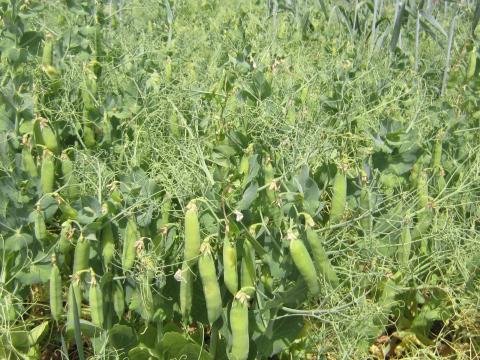Quick Facts
- The pea crop is a grain legume, which produces a high protein feed for animal or human nutrition.
- As peas fix nitrogen and are a different crop type to cereals, they are an excellent break-crop giving a boost to the following cereal yield and reducing production costs.
- In animal diets, peas provide a high protein component and are sometimes favoured over beans in starter diets and specialist feeds.
- The risk of harvesting problems and crop losses are still a feature of pea production but limited varietal improvements have been achieved. .
- There is a very limited market for peas for human consumption.
- The scope to increase pea production is constrained by a combination of: limited market; harvest challenges and relatively poor breeding and agronomy research support.
Crop Description
- Peas (pisum sativum) are a leguminous plant with the ability to fix nitrogen, eliminating the need for applied N in the year of production, and leaving residual N for the following crop.
- Peas suitable for combining are primarily used for the animal feed market but combining peas can also be used for human consumption. Peas are classified by flower colour and seed coat colour. Combining peas are generally white flower type; but these can be further classified as: white, large blue, small blue and marrowfat seed types.
Markets
- The market for combinable peas in Ireland is both for human nutrition and for animal feed, In total an estimated 800 to 1000ha are grown annually.
- The scope for high protein feeds in Ireland is significant where more than 1.2 Mt of imported protein feed could be displaced (primarily Soya and Maize Distillers meal).
- Peas can be used like beans to displace imported protein in all animal rations for both ruminants and monogastrics.
- Nutritionally peas are similar to beans but with slightly different characteristics making them more attractive for inclusion in starter and specialised rations.
- There are a range of processed products from peas that have further potential uses in animal and human diets. These include: pea cream (for animal feed after extraction of some of the starch and protein); pea protein for inclusion in animal milk replacers; Concentrated pea protein (e.g Lysamine) for use in piglet diets; pea starch.
- While peas have some nutritional difference compared to beans which makes it more suitable for specific end uses, there is a challenge in seeking to develop all of these markets and crop types in a relatively small country. Should the focus be on developing just one legume crop and its markets or a number of crops (and variety variants) for specific markets?
Suitability for Ireland
- Peas grow well in the Irish climate; however if wet conditions prevail at harvest, harvesting capacity can be reduced and crop losses increased. For this reason, the quantity of peas grown by individual growers tends to be small to ensure there is sufficient harvesting capacity to cope with challenging conditions.
- Peas are best on lighter to medium textured soils contrasting with beans favouring more moisture retentive soils.
- Similar field equipment to that used for cereal production is required.
- Most of the experienced pea producers are concentrated in one geographical area in Ireland as are merchants creating a constraint to expansion.
Rotation/Break Crop Benefits
- Peas are legumes, and fix atmospheric N which allows the plant achieve its high protein content, but also supplies N for growth eliminating the need for fertiliser N. and reducing the requirement for fertiliser N in the following crop.
- As a completely different crop type to cereals, peas act as a useful break in many disease and pest cycles, benefitting yield and cost reduction in the following crop.
- Growing a non-cereal like beans may bring some opportunities for alternative weed control strategies.
Research and Development Status
- Overall there is a significant deficit in breeding and research for legumes in temperate climates. Specifically with peas the breeding effort is diluted by the many diverse pea types and market requirements.
- For Ireland breeding for traits that optimise production and harvesting in our climate is necessary.
- All aspects of crop physiology; in particular yield formation and factors contributing to it, need further research in our climate, to ensure agronomy, from crop establishment and sowing date to nutrition and disease control, can be tailored to optimise crop structure for yield.
- Pest and weed control challenges also need to be addressed.
Crop Production Summary
- Decide on an end use market and secure a contract if necessary.
- Select a suitable site (soil type and rotation position) and variety.
- Sow when soil conditions are suitable in spring (March April) with conventional sowing equipment targeting a plant population of 65-70 plants / m2
- Fertiliser P and K should be applied on the basis of soil nutrient test status. Soil pH should be corrected by liming if necessary. Peas do not require fertiliser N.
- Good weed control is essential using pre-emergence products.
- Peas can suffer from a range of diseases including downy mildew, grey mould and leaf and pod spots can occur and need to be monitored and controlled.
- Pests include birds (crows) at sowing, pea/bean weevil at early plant development and pea aphids; all which may need control methods depending on threshold levels.
- Combine harvesting needs to be carefully managed with dessication, the use of crop lifters and careful combining to be considered to avoid losses.



